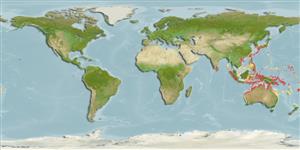>
Gobiiformes (Gobies) >
Gobiidae (Gobies) > Gobiinae
Etymology: Echinogobius: Greek, echinos = sea urchin, hedgehog + see under Gobius; hayashii: Named for Masayoshi Hayashi..
Environment: milieu / climate zone / depth range / distribution range
Ökologie
seewasser riff-verbunden; tiefenbereich 1 - 20 m (Ref. 30347). Temperate
Indo-West Pacific: Western Australia and Japan.
Size / Gewicht / Alter
Maturity: Lm ? range ? - ? cm
Max length : 7.0 cm SL Männchen/unbestimmt; (Ref. 30347)
Kurzbeschreibung
Morphologie | Morphometrie
Rückenflossenstacheln (insgesamt): 6 - 7; Rückenflossenweichstrahlen (insgesamt): 12; Afterflossenstacheln 1; Afterflossenweichstrahlen: 12. Characterized by pale grey color grading to white ventrally; presence of blue-edged red to pink band from occiput to cheek; side of body with variable-sized brown spots on side of body and on dorsal and caudal fins; some larger spots (on shoulder region and first dorsal fin) surrounded by small blue-white spots; upper half of side of body and along base of second dorsal fin with scattered small blue-white spots; hard and pungent first dorsal spine of first dorsal fin, fifth spine forming short filaments; lanceolate caudal fin; longitudinal scale series 29-32; all scales cycloid; predorsal scales absent; depth of body 6.8-7.8 in SL (Ref. 90102).
Occurs on clear sandy bottoms with fast tidal currents. Retreats in burrows made possibly by sea cucumbers or polychaetes (Ref. 30347).
Life cycle and mating behavior
Geschlechtsreife | Fortpflanzung | Ablaichen | Eier | Fecundity | Larven
Iwata, A., S. Hosoya and Y. Niimura, 1998. Echinogobius hayashii, a new genus and species of Gobiidae. Ichthyol. Res. 45(2):113-119. (Ref. 30347)
IUCN Rote Liste Status (Ref. 130435)
Bedrohung für Menschen
Harmless
Nutzung durch Menschen
Mehr Information
NamenSynonymeMetabolismusRäuberÖkotoxikologieFortpflanzungGeschlechtsreifeAblaichenSpawning aggregationFecundityEierEientwicklung
Alter/GrößeWachstumLänge-GewichtLänge-LängeLängenhäufigkeitenMorphometrieMorphologieLarvenLarven Pop.Dyn.RekrutierungDichteBRUVS
ReferenzenAquakulturAquakultur ProfilZuchtlinienGenetikElectrophoresesVererbbarkeitKrankheitenVerarbeitungNutrientsMass conversion
PartnerBilderStamps, Coins Misc.LauteCiguateraGeschwindigkeitSchwimmstilKiemenoberflächeOtolithsGehirngrößeSehfähigkeit
Tools
Zusatzinformationen
Download XML
Internet Quellen
Estimates based on models
Preferred temperature (Ref.
123201): 21.9 - 29.3, mean 28.4 °C (based on 1429 cells).
Phylogenetic diversity index (Ref.
82804): PD
50 = 1.0000 [Uniqueness, from 0.5 = low to 2.0 = high].
Bayesian length-weight: a=0.00708 (0.00333 - 0.01504), b=3.09 (2.92 - 3.26), in cm total length, based on LWR estimates for this (Sub)family-body shape (Ref.
93245).
Trophic level (Ref.
69278): 3.3 ±0.3 se; based on size and trophs of closest relatives
Widerstandsfähigkeit (Ref.
120179): hoch, Verdopplung der Population dauert weniger als 15 Monate. (Preliminary K or Fecundity.).
Fishing Vulnerability (Ref.
59153): Low vulnerability (10 of 100).
